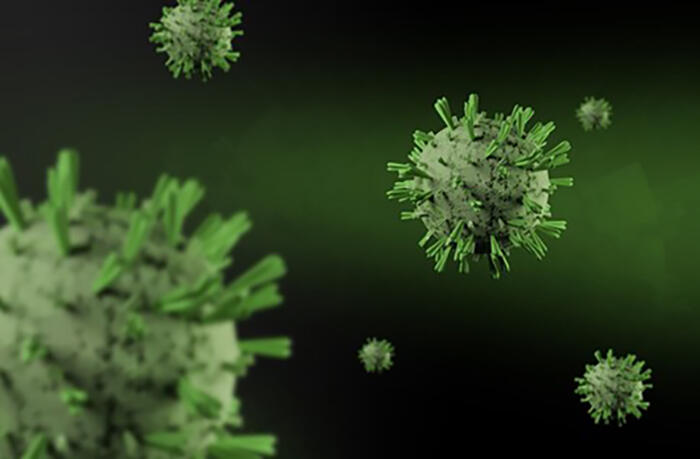The COVID-19 virus infects people by fusing the virus's outer membrane with cell membrane and with endosomal membranes through a mechanism called envelope fusion. Receptors on the cell membrane and proteolytic enzymes (proteases) play important roles in this fusion. Project Senior Assistant Professor Mizuki Yamamoto and Project Associate Professor Jin Gohda of the Research Center for Asian Infectious Diseases in The Institute of Medical Science at The University of Tokyo, together with Emeritus Professor and Specially Appointed Professor Jun-ichiro Inoue of The University of Tokyo, discovered a new transmission route for the COVID-19 virus that does not depend on the serine/cysteine proteases which were already known to be involved in membrane fusion. This new pathway depends on metalloproteinases and is a pathway that is unique to the COVID-19 virus, not being seen in the SARS and MERS coronaviruses.
Additionally, the research group found that multiple metalloproteinase inhibitors, which have been in development as cancer metastasis inhibitors, effectively inhibited this pathway and suppressed the viral infection-dependent cell fusion and cell death that are associated with COVID-19 pathophysiology. These results are expected to not only clarify the mechanism behind the rapid spread of COVID-19 infections and COVID-19's complicated pathophysiology, but will also be useful in the development of treatment methods for aggravated disease and aftereffects as well as for predicting the pathogenicity of new COVID-19 variants. The research was published in the online version of mBio.

The research group used a membrane fusion assay system, which evaluates the fusions of viral outer membranes with cell membranes, to identify infection inhibitors such as nafamostat (fusan). Using this assay system, they discovered that the COVID-19 spike protein, unlike the spike proteins on the SARS and MERS coronaviruses, induces membrane fusion in a TMPRSS2-independent manner.
The researchers screened a library (distributed by the Drug Discovery Initiative at The University of Tokyo) of approx. 3,000 compounds, such as existing drugs and molecular-targeted drugs, and found that inhibitors for a wide range of metalloproteinases, such as ilomastat and CTS1027, effectively inhibited TMPRSS2-independent membrane fusion, which revealed that some metalloproteinases are important for these membrane fusions.
Metalloproteinase is a general term for proteolytic enzymes, including the MMP (Matrix metalloproteinase) and ADAM (a disintegrin and metalloproteinase) families, and have been shown to be involved in the metastasis and invasions of solid tumors. Previously, clinical trials of metalloproteinase inhibitors, such as marimastat and prinomastat, have been held for the purpose of inhibiting cancer metastasis and invasions, and a certain level of safety has been confirmed for administering them within the body. From this, when the researchers investigated the inhibitory effect of these metalloproteinase inhibitors (with potential clinical applications) on membrane fusions via the COVID-19 spike protein, the researchers found that they specifically inhibit TMPRSS2-independent membrane fusions.
Next, in order to determine what kind of tissue-derived cells this metalloproteinase -dependent membrane fusion is important for in terms of COVID-19 infections, the infection-inhibiting effects of marimastat were analyzed in a variety of cell lines by using a psuedovirus that expressed the COVID-19 spike protein. The results showed that marimastat effectively suppressed pseudoviral infections in cell lines derived from the kidneys, the membrane lining the uterus, and the ovaries, but showed no suppressive effect in cell lines derived from the lungs or large intestines. That is to say, COVID-19 infection via metalloproteinases has cell specificity.
Furthermore, amongst the family of highly pathogenic coronaviruses, in order to investigate the mechanism by which only the COVID-19 spike protein can utilize metalloproteinases, the research group created a pseudovirus with a chimeric spike protein (whose structure had been partially replaced) and compared it with the SARS coronavirus spike protein (which cannot cause infections via the use of metalloproteinase, despite having a spike protein structure that is similar to that of COVID-19). As a result, for infections utilizing metalloproteinases, it was found that the spike protein requires both 1) having a COVID-19 derived sequence that is cleaved by a proteolytic enzyme called Furin at the boundary between the S1 and S2 domains, and 2) having an S2 domain on the C-terminal side of the COVID-19 spike protein.
Using specific inhibitors and gene knockdown methods, an analysis was also performed in order to identify factors on the target cell side, and it came to light that a metalloproteinase called ADAM10, which works on cell membranes, has an important function.
Additionally, the research group found that the suppression of cell fusion and cell death by marimastat and prinomastat was dependent on COVID-19 infection at concentrations that are below the blood concentrations used in previous clinical trials. Cell fusion and cell death may be involved in a variety of COVID-19 pathologies, and this research suggests the importance of metalloproteinases as therapeutic targets.
Journal Information
Publication: mBio
Title: Metalloproteinase-Dependent and TMPRSS2-Independent Cell Surface Entry Pathway of SARS-CoV-2 Requires the Furin Cleavage Site and the S2 Domain of Spike Protein
DOI: 10.1128/mbio.00519-22
This article has been translated by JST with permission from The Science News Ltd.(https://sci-news.co.jp/). Unauthorized reproduction of the article and photographs is prohibited.




